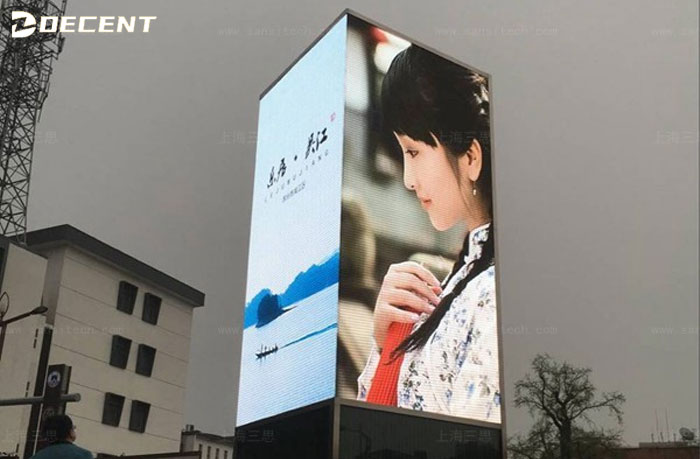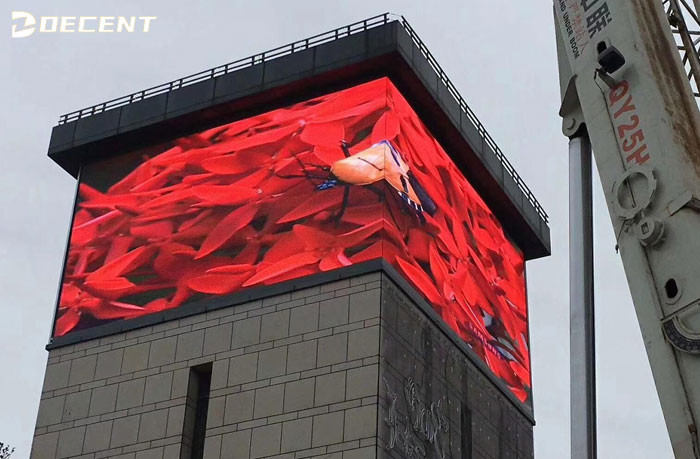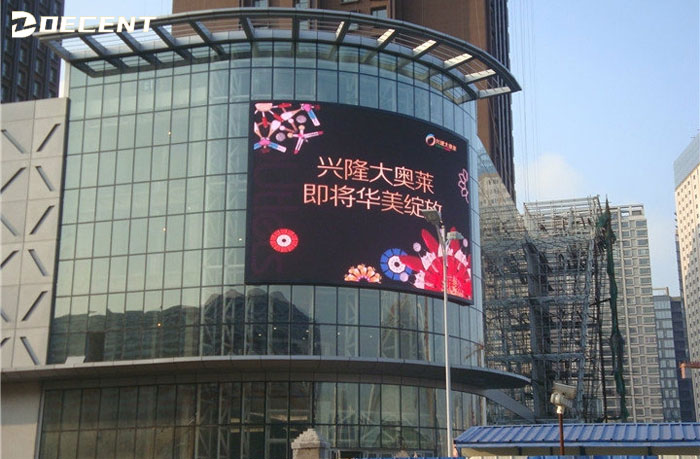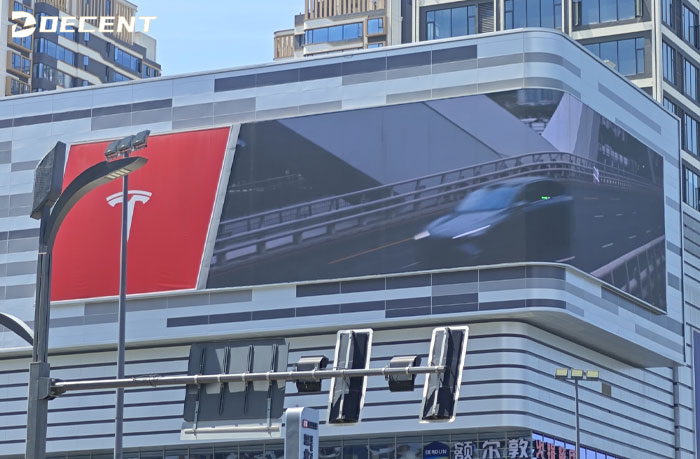



Outdoor LED display screen have become a dominant force in modern advertising and information dissemination. Their vibrancy, durability, and ability to capture attention make them invaluable for businesses, events, and public spaces. A critical factor determining the clarity and effectiveness of an outdoor LED screen is its dot pitch. Selecting the appropriate dot pitch is essential for achieving the desired visual impact and ensuring a good return on investment.

Dot Pitch (also known as pixel pitch) is the measurement, in millimeters, from the center of one LED pixel to the center of the adjacent LED pixel. It directly determines the screen’s resolution and clarity.
Smaller Dot Pitch: Means the pixels are closer together. This results in a higher pixel density (more pixels per square meter), producing a sharper, more detailed image with a smoother appearance. This allows for a closer minimum viewing distance.
Larger Dot Pitch: Means the pixels are farther apart. This results in a lower pixel density, which is suitable for viewing from greater distances. Screens with a larger pitch are generally more cost-effective.
Choosing the right dot pitch is a balance between resolution, viewing distance, budget, and content type.
The minimum viewing distance is the closest distance at which a viewer can still see a clear, coherent image without distinguishing individual pixels. This is the most crucial factor in selecting dot pitch.
General Rule: The minimum viewing distance (in meters) is approximately equivalent to the dot pitch (in millimeters) multiplied by a factor (often between 1.5 and 2.5). For instance, a P10 screen (10mm pitch) is often suitable for a minimum viewing distance of around 10-25 meters.
Long-Distance Viewing: For large billboards viewed from hundreds of feet away, such as on highways, a larger pitch like P20 or even P31.25 (with a minimum viewing distance of 25m or more) is perfectly adequate and more economical.
Short-Distance Viewing: For screens in pedestrian zones, shopping malls, or bus stops where people might be only a few meters away, a smaller pitch like P6 or P8 is necessary to maintain image quality.
The nature of the content you plan to display influences the required resolution.
Text & Detailed Graphics: If your content involves small text, intricate graphics, or high-definition videos, a smaller dot pitch (P4-P8) is essential for readability.
Large Images & Video: For larger, simpler images and video content viewed from a standard distance, a medium pitch (P10-P16) is often sufficient.
Basic Branding: For very large formats where the core message is simple and bold, a larger pitch (P20+) can be effective.
Dot pitch significantly impacts cost.
Higher Cost: Screens with a smaller dot pitch (higher resolution) use more LEDs and intricate technology, making them more expensive per square meter.
Lower Cost: Screens with a larger dot pitch (lower resolution) are generally more budget-friendly upfront.
It’s important to weigh the initial investment against the intended use and desired effect.
Outdoor screens face sunlight, rain, and temperature fluctuations. While dot pitch doesn’t directly affect environmental resilience, it’s part of the overall module design.
Brightness: Outdoor screens require high brightness to combat ambient sunlight. Most outdoor LED displays have a brightness of at least 5,000 nits. For instance, a P31.25 model can reach 6,000 nits, while a P8 model can offer ≥5,500 nits.
IP Rating: Ensure the modules have a high Ingress Protection (IP) rating (IP65) for dust and water resistance, which is crucial for longevity outdoors.

Here is a quick reference guide to typical outdoor dot pitches:
| Dot Pitch | Pixel Density (approx.) | Minimum Viewing Distance | Best For |
|---|---|---|---|
| P4 – P6 | 27,777 – 17,222 pts/m² | 4 – 10 meters | High-end retail, pedestrian zones, close-range advertising. High clarity. |
| P8 – P10 | 10,000 – 17,222 pts/m² | 8 – 25 meters | Stadiums, shopping plaza facades, medium-distance viewing. Good balance. |
| P16 – P20 | 2,500 – 6,400 pts/m² | 16 – 50 meters | Larger billboards, rooftop signs, main roads. Cost-effective for size. |
| P25+ | < 2,500 pts/m² | 25+ meters | Very large billboards along highways, megastructures. Maximum distance. |

When selecting an outdoor LED display, also pay attention to these technical specs:
Refresh Rate: A higher refresh rate (≥480Hz) ensures smooth video playback without flickering, especially when recorded.
Grayscale: Higher grayscale levels (e.g., 10-bit, 1024 levels per color) provide smoother color transitions and more depth (over 1 billion colors).
Viewing Angle: A wide viewing angle (e.g., H:160°/V:90°) ensures the image remains clear for viewers at the sides.
Cabinet Design: Durable, lightweight cabinets that are easy to install and maintain, with good heat dissipation and protection levels.

There is no single “best” dot pitch for all outdoor LED displays. The most suitable choice is a direct function of your typical audience’s viewing distance and your content needs.
Identify the Minimum Viewing Distance: Determine how close people will get to your screen.
Match Pitch to Distance: Use the general rule (Pitch in mm ≈ Min. Distance in m / 1.5-2.5) as a starting point.
Consider Content and Budget: Decide if your content demands higher resolution and if it fits your budget.
Prioritize Outdoor Durability: Never compromise on brightness (≥5,000 nits) and a high IP rating (IP65).
![]()
By carefully evaluating these factors, you can select the outdoor LED display screen with the perfect dot pitch that delivers stunning, clear, and effective visuals for your specific application.
contact us
Stay up-to-date with our new product releases and latest news articles. DECENT Technology is a leading global supplier of LED display screens, providing customers worldwide with comprehensive solutions for the research and development, manufacturing, engineering installation, and after-sales service of high-end LED display equipment and display control systems. At present, it has developed into a national high-tech enterprise with over 1300 employees and more than 400 authorized national patents. The company has successively obtained safety production license, steel structure construction qualification, system integration qualification, third level professional contracting for building mechanical and electrical installation engineering, and second level professional contracting for electronic and intelligent engineering.
DECENT Technology is positioned as "core technology oriented" and has deeply cultivated and worked in the LED industry. It has established numerous marketing centers, offices, and after-sales service outlets worldwide. The company's products are distributed in more than 200 countries and regions, and has accumulated over 40000 classic cases. The strong comprehensive strength has made DECENT Technology the preferred brand among the Fortune Global 500 companies such as Sinopec, PetroChina, Tencent, Alibaba, Huawei, and Abbott.
Since its establishment, DECENT Technology has accumulated 10 industry-leading technologies and 43 innovative "black technology" technologies; And we have developed six product lines, including professional display, universal display, conference display, commercial display, outdoor led display, and rental display, which are applied in multiple scenarios such as command and monitoring, commercial display retail, broadcasting and broadcasting, outdoor advertising, sports events, and stage performances. The product quality maintains a leading position in the industry.
In the future, DECENT Technology will continue to adhere to the business philosophy of "product+service" and the corporate values of "innovation, sunshine, struggle, and gratitude", continuously moving towards higher technology, better services, and harder quality, committed to providing professional LED display system solutions for every customer.
DECENT Technology is a leading global supplier of LED display screens, providing customers worldwide with comprehensive solutions for the research and development, manufacturing, engineering installation, and after-sales service of high-end LED display equipment and display control systems. At present, it has developed into a national high-tech enterprise with over 1300 employees and more than 400 authorized national patents. The company has successively obtained safety production license, steel structure construction qualification, system integration qualification, third level professional contracting for building mechanical and electrical installation engineering, and second level professional contracting for electronic and intelligent engineering.
DECENT Technology is positioned as "core technology oriented" and has deeply cultivated and worked in the LED industry. It has established numerous marketing centers, offices, and after-sales service outlets worldwide. The company's products are distributed in more than 200 countries and regions, and has accumulated over 40000 classic cases. The strong comprehensive strength has made DECENT Technology the preferred brand among the Fortune Global 500 companies such as Sinopec, PetroChina, Tencent, Alibaba, Huawei, and Abbott.
Since its establishment, DECENT Technology has accumulated 10 industry-leading technologies and 43 innovative "black technology" technologies; And we have developed six product lines, including professional display, universal display, conference display, commercial display, outdoor led display, and rental display, which are applied in multiple scenarios such as command and monitoring, commercial display retail, broadcasting and broadcasting, outdoor advertising, sports events, and stage performances. The product quality maintains a leading position in the industry.
In the future, DECENT Technology will continue to adhere to the business philosophy of "product+service" and the corporate values of "innovation, sunshine, struggle, and gratitude", continuously moving towards higher technology, better services, and harder quality, committed to providing professional LED display system solutions for every customer. Do you have any questions or requests?
Click below, we are happy to provide assistance. contact us